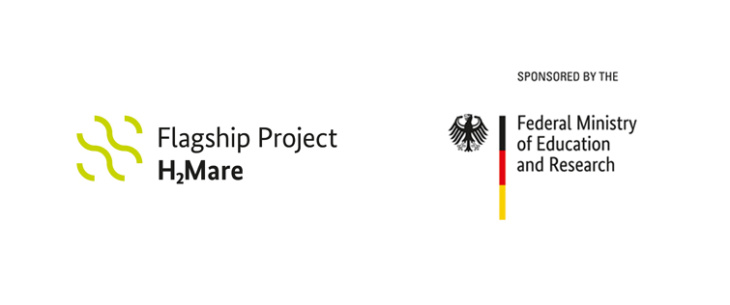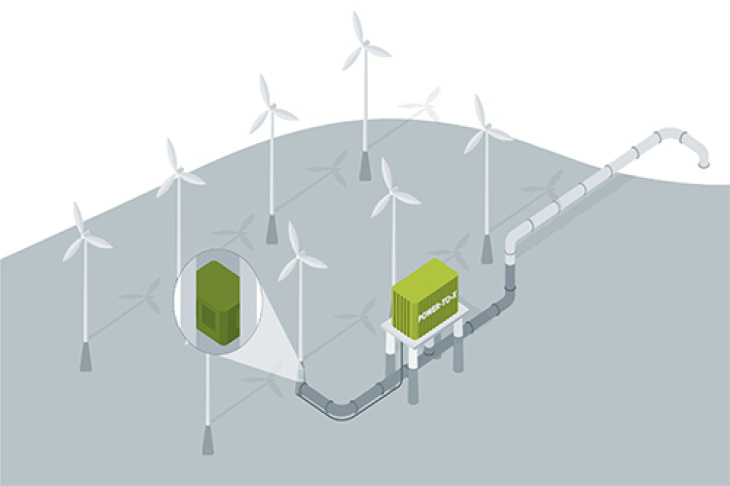Green hydrogen from offshore wind power
H2Mare is one of three hydrogen flagship projects, funded by the German Federal Ministry of Education and Research (BMBF) with a total of up to 740 million euros. In H2Mare, the production of green hydrogen and a range of different secondary products with offshore wind power, will be investigated together with around 32 partners from science and industry, over the four year lifetime of the project. With four of its institutes, the Helmholtz-Zentrum Hereon supports technology development for sustainable and environmentally friendly energy production and its conversion to secondary products.

To achieve greenhouse gas neutrality by 2045, Germany must drastically reduce its carbon footprint. The production of green hydrogen, obtained from renewable electricity, can make a significant contribution to this policy goal. The flexible energy carrier and secondary products derived from it, such as ammonia, methanol and synthetic fuels – called Power-to-X (PtX)-products ̶ can store the excess energy generated, and can be used in industry, or the transport sectors for example, thus serving to replace the use of fossil fuels.
For the production of green hydrogen, offshore wind farms show great potential, because large areas with more consistent wind are available, and there are fewer conflicts concerning their use compared to onshore windfarms. To exploit this potential in the future, H2Mare is exploring the direct production of hydrogen and other PtX-products in a maritime environment. This also offers the opportunity to circumvent the challenge of grid connection and to make the fluctuating renewable energy storable and transportable, thus permanently relieving the electricity grids. Hereon is involved in two H2Mare projects: the "PtX-Wind" project is developing and testing options for an open-ocean platform to directly produce hydrogen and PtX-products from offshore wind energy. The second project with Hereon participation is called "TransferWind" and is dedicated to the implementation of the developed technologies and knowledge exchange between science, politics, business, and society.
The offshore production of hydrogen and other PtX-products is considered one of the future technologies for the energy transition and may also help to reduce dependence on energy imports. There are, however, many open questions and challenges that need to be resolved before this can become reality. These relate, among other things, to the environmental impact, operation and sustainability of the platform, costs and economic viability, and social acceptance. Four different Hereon institutes are helping to answer these questions over the course of the project: the Institute of Membrane Research, the Institute of Coastal Environmental Chemistry, the Institute of Coastal Systems - Analysis and Modeling, and the Climate Service Center Germany (GERICS).
Four institutes - many tasks

Offshore wind power has high potential for the production of green hydrogen. Graphic: Projektträger Jülich on behalf of the BMBF
The Institute of Membrane Research faces the challenge of producing long-term stable membranes for seawater treatment for electrolysis processes. The so-called fouling on the membrane surface needs to be minimized. This means chemically modifying the membranes to reduce the formation of a biofilm. "We will develop membranes with improved properties for this process in order to prepare seawater for the various processes," said Dr. Volkan Filiz, department head at the institute.
The Institute of Coastal Environmental Chemistry primarily brings chemical analytical experience to the study of pollutants in marine environmental samples. This helps to identify potential emissions from offshore platforms, such as (heavy) metals or organic pollutants, at an early stage and consequently to further reduce emissions. "Emissions can arise, for example, from wastewater treatment plants, seawater cooling systems, fire protection systems, oil discharges, increased shipping traffic or from the necessary corrosion protection measures of the structures," said Dr. Daniel Pröfrock, department head at the institute.
The Institute of Coastal Systems - Analysis and Modeling studies weather and environmental conditions in order to develop safety concepts on this basis. "To do this, we create data that allow us to assess the risk to the platforms and the transportation of the PtX-products. These data include wind speeds and directions, as well as sea swell and currents" said Dr. Beate Geyer, coastal researcher at the institute.
GERICS is addressing the question of what potential impact the production of hydrogen and other PtX-products at sea will have on the local population and other stakeholders, such as fisheries, nature conservation or tourism. Related to this, the researchers are also investigating the acceptance for an offshore PtX-platform. "We rely on dialogue with stakeholders. This allows us to disclose the different positions and discuss them together with project partners," said Dr. Paul Bowyer, department head at the institute.
Big challenges, big goals
The goals that H2Mare is pursuing are to create the conditions for producing climate-neutral and easily transportable energy sources offshore, to enter into discussions with local stakeholders, and to develop self-sufficient solutions, so that connection to the power grid at sea is no longer necessary. In addition, the experience gained in the development of a production-ready PtX production platform may also find application in other countries and contexts. Therefore, the project will not only support the development of the German hydrogen economy, but also offers the potential to make a global contribution to reducing our collective carbon footprint.
Further Information
Contact
Climate Service Center Germany (GERICS)
Helmholtz-Zentrum Hereon
Communication and Media
Helmholtz-Zentrum Hereon
